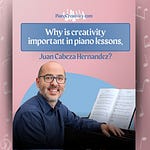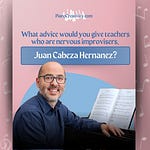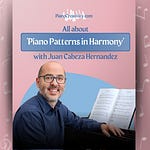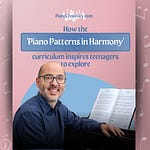In this inspiring in-depth interview, Professor Karen Schlimp shares a great deal of wisdom and some brilliant quotes that’ll help you as you integrate more creativity into your lessons. It’s well worth diving in (if you’ve not got time today, bookmark it and watch it on the weekend!)
It’ll be of particular interest to those of you who are currently unaware of the excellent quality of German-language creativity pedagogy. Here in central Europe we have a really rich tradition of teaching improvisation and composition and Karen (who is Austrian) dicusses and demonstrates resources from the wonderful pedagogues Francis Schneider (Swiss) and Herbert Wiedemann (Germany).
Topics covered
About Prof. Karen Schlimp
Karen is an extremely experienced improvisation teacher with an enormous amount of knowledge and practical experience to share. An Austrian native, she is a Professor at the Anton Bruckner Privat University in Linz, and a Lecturer for Ensembles and Improvisation at the Music University in Salzburg and Vienna. She is also the author, with Peter Jarchow, of Impromosaik: das verrückte Klappbuch mit unbegrentzen Ideen zum Improvisieren (“the crazy folding book with unlimited ideas for improvisation”), published by Breitkopf & Härtel, and Klangwege: Improvisation anregen — lernen — unterrichten, (“Soundpaths: stimulating improvisation — learning — teaching”) published by Lit Verlag.
Links
Karen’s website: pianomobile.com
Karen’s books:
Impromosaik (Breitkopf & Härtel) [German language]
Klangwege: Improvisieren anregen — lernen — unterrichten (Lit Verlag) [German language]
Other resources Karen recommends:
Herbert Wiedemann: Impulsives Klavierspiel (Bärenreiter) [German language]
Francis Schneider: In Tönen Reden (Breitkopf & Härtel) [German language]
I mention Andrew Eales’ article “Sound Before Symbol: lessons from history”
Karen’s events:
Transcription
Introduction
Garreth: So hello and welcome to www.pianocreativity.com. This is an interview with Karen Schlimp, who is a professor at the Anton Bruckner Privat University at Linz and a lecturer for ensembles and improvisation at the music university in Salzburg in Vienna. And she's also author with Peter Jarchow of this wonderful book, Impromosaic, which we're going to talk about later.
Thank you very much for talking to us, Karen.
Karen: Hello.
The Benefits of Improvisation in Music Education
Garreth: The first question I have for you is what do you think are the benefits of including creativity like improvisation and composition in piano lessons?
Karen: For me improvisation is like speaking and when we are musicians, we could speak with our instrument and with music as well as we speak in language and we can read great books: that's like composition. So for me, there is no contradiction because in language, we speak and we read, and we also [00:01:00] can write, this is composing. So for me, these three things can really come together in, in piano lessons and in life as well.
Garreth: I absolutely agree. I often think, when my students are nervous about improvising, I talk to them and I say, I'm improvising what I'm saying to you now. I don't, I haven't got it written down in my head, I'm just making it up. And that's what conversation is. Improvisation is conversation.
Karen: Yeah, for me too. Because when children learn to speak, they just try out and readily, they can speak and afterwards they go to school and learn, write and, and reading. And in, in Western music, it's most of the time the other way around. And it makes me a little bit sad because it could be integrated all together. And if people are scared about improvisation, I don't use the word improvisation. I just say play free.
Garreth: Yeah, me too. I find that's really, it's liberating [00:02:00] actually, isn't it? Because the word improvisation makes people feel nervous.
How do you get your students to feel relaxed when improvising?
Garreth: That's actually something some of my readers have asked about how do you get your students to feel relaxed when they're improvising? And obviously "play free" is part of that, but do you have any other tips for them?
Karen: You have to have something to hold onto so that you feel comfortable. And there must be some challenge where you be free. Learning usually is at the border between where you are challenged and you feel comfortable. So if a student is not, not very familiar with improvisation, I give them a good material that they know what to play and, and then I give some freedom. And if somebody is more a creative person who wants to have a lot of freedom, I give them not so much material. But sometimes even those people who like to improvise a lot, if they get structured, they find new ideas. So for me, it's always the balance [00:03:00] between structure and freedom.
Garreth: That's really interesting. That's very true for me as well.
Adapting Improvisation Techniques for Different Levels
Garreth: So if you were teaching a lesson to an elementary student and you were including some improvisation, how would you do that? Let's say they're eight years old.
Karen: For me, it's always depending which material we want to use. If they want to play with two chords, I just give them two chords and maybe if he or she is the beginner, I use maybe five notes and they can play the chords in a special beat and then they can use the melody to play over it.
So this is harmonic improvisation when I use chords. So then they can listen which note fits to the chords and then they can stay on the chord. And when they say, okay, this note doesn't fit to the chord, it's a suspension and I can, you know, stay on it to make the music more [00:04:00] interesting, or I can resolve it and play the note above or below.
Because with this method, I get them to listen and not say "this note is right or wrong." Because in improvisation, we need this possibility to know what we are saying, like in language. And then we can go in a different ways to play above, below, stay on a note, increasing tension or resolving tension of the music. I don't use the word right or wrong.
Garreth: Yeah.
Karen: So if we speak in musical terms, it's consonance or dissonance, but with elementary, I don't use these words. I say, okay, does it make the music more interesting or does it make it more soft and relaxed? And then I also let them find their own words for if a note fits in a chord or not, or if it's a suspension, so that they find their language of hearing and [00:05:00] listening.
Garreth: That's great. So, so just to get, I think that my understanding was that, for example, they would play a C chord, a C major chord and an F major chord, and they might play in the C major pentascale. And as they move between those chords, they would, you'd encourage them to listen for when it was consonant and dissonant, but without using those words. Is that right?
Karen: Yeah.
Garreth: That's great. The language thing is really powerful, isn't it? When you use the words right and wrong, it could create a fear. But when you say, is that an interesting sound? It's quite exciting for kids, isn't it?
Karen: Yeah, yeah. Because right or wrong, we are so much in the school system that a teacher asks this question and the students need to know what does he want to hear. But in music, if you want to become creative, you don't need to have "right" or "wrong", you can say, okay, it can sound like this, or it can sound like this and every, every way I play it [00:06:00] has different effect on the listener.
Garreth: Yeah. Sometimes a lot of my students... I quite like very consonant music. And a lot of my students are much more interested in dissonant music than I am, which I find very interesting. And so often we, we don't quite agree about what sounds good, but I think that's, that's what makes it interesting. Isn't it?
Karen: Yeah. I think what is important to know what we are doing— knowing means also in a intuitive way, okay, "it's a tension chord" or "this is a no tension chord."And so that we can really use it in the way we want to do it. Or if it's happening randomly, that we know what to do afterwards. Like this famous quotation from Miles Davis, "if you hit the wrong note, it's the next that makes it good or bad", but it's not a "wrong" note. It's maybe a dissonant note, or it's a note which is not fitting in the style.
I always bring this [00:07:00] example from chords when you use an F sharp in G major in Baroque music it's fine. If you use a natural F then you get this special jazz chord where you can use F sharp and not a natural F. So it's depending on the style. It's like if you use foreign language words in one language, it's fitting in another language you don't understand.
Garreth: Yeah, that's so true.
Karen: It's always the question of the frame or the style or the genre, where you say "it fits" or "not fitting", but it's not "right" or "wrong". It's a kind of reframing. And it's also reframing thinking.
Garreth: Yeah. So I think when you first start teaching, it sounds like you do a little bit like me. It's very free with the younger kids, but you're helping them to develop a vocabulary about what they like and what they don't like. And then later on you start teaching them about [00:08:00] genre and and what would be stylistically appropriate. Does that sound like what you're doing?
Karen: Yeah, yeah, because I mean we have so many styles of music and when we I mean on the piano we have this temperate scale and we have chords. So if we work with harmonies, we have this in many styles. We have this in Baroque music, in classical music, in jazz, in pop. So to get this differentiation, then you can work on articulation of phrasing or something, but this, this basic of, of harmony of bar of scales, I think this is in all those styles similar.
Exploring 'Impromosaic': A Tool for Creative Music Making
Garreth: So I've really enjoyed your Impromosaik book and my students have too. And I think what I really like about it is that it's flexible. And it's quite unpredictable, and it's the combination of quite clear [00:09:00] instructions that appear in a completely unpredictable way. I'm just going to sort of show some of the people watching how it works.
So, in the book, you've got five different cards. There's a start card two change cards, a card about suggestions for how it could be arranged, and then a card about the overall goal of the piece. So, for example, if we were to start with a start card here, "Spiele eine absteigende Linie" which means play a descending line, and then I'll turn to another card "Articuliere frei, aber deutlich."
That means articulate freely, so choose your articulations, but clearly. It's really great, that one. "Spiele in schnellem Tempo" so play in a fast tempo. I'll choose, there's various different ones for the arrangements. There's piano wind instruments, strings, and song. I've only really used the, the piano suggestions.
One I [00:10:00] really like is "Eine Hand übernimmt das, was die Andere gespielt hat," which is one hand takes over what the other hand has just played. And then the final card is the, the goal card. And so the one I'm on here says, "Spiel drei märchenhefte Stücke, die neugierige Nixe, die hinterhaltige Hexe und das Zaubertor." I'm not actually sure what the "Nixe" is but... so it's a curious nymph, I guess the,
Karen: It's water ladies.
Garreth: Ah, yeah, the water, yeah, the water nymph, so the curious water nymph, the devious witch and the magical gate. And so you'd, using all of those prompts, it's very easy to come up with really really creative pieces. And it works really well with kids and adults, which is the thing I particularly enjoy. And what I really like about it is if you're, if you find yourself getting stuck on a prompt, you just turn the page and pick another prompt.
And, and you can do that, you could do that right from the start card. So here it's got "Spiele abwechselnd [00:11:00] Quinten und einzelnde Töne," so switching between fifths and single notes. And it's so easy and so unpredictable. It's really fun. And so congratulations on a really great concept. What prompted you to create the book?
Karen: Behind the book, there is the idea of variation. So people often get stuck in improvisation at "I don't know what to do." And it's a way to develop skills. And the first skill is: you can use all the musical parameters like rhythm, articulation, phrasing, harmonies, melody, intervals, pitch, and so on.
And if you start with an idea, it can be any idea and you change one of the parameters, you develop the improvisation. So this is the idea behind. it And when we developed this book, we did it very systematically and all [00:12:00] these parameters and then we mixed it. Because this is how improvisation is working, we, we start with an idea and then we continue, continue, continue, and ideas come randomly and we use them or we decide not to use them.
But if people have not got this flowing of ideas, we want to give them the skills that they know they can change parameters. Just one parameter, change sound- color, change octave, change the, the function of the hand. If here I play an accompaniment and then melody, if I play them here, accompaniment in there, here melody, just the improvisation is changing.
And to give them the tools that they can improvise fluently just by changing parameters. And so the cards of the book is just mixed so that you, you are in this attitude of [00:13:00] improvisation where these ideas can come randomly or by if you want them, you can also think of the parameters so that you couldn't use them both.
Yeah, so that's the idea. And also we wanted to keep it really neutral in sense of styles, in sense of level, because you can start this improvisation as a beginner. as well as a very advanced improviser because everyone is doing his own development out of that.
Garreth: Very true. I've used it with some quite advanced students and it's really fun and, but it equally works with quite young children. It's great.
Karen: Yeah. And it's like, maybe a little bit like our brain works. We start with an idea and then we continue. And if we don't have an idea, we can just turn the page. And so the first four cards are just material to [00:14:00] develop. And then last, the gold cards if you want to improvise a whole piece, like a Sonata or a Nocturne, or then you can use this card. And the first four cards are more by, for practicing for, choosing special goals or getting ideas.
Garreth: And actually that's one of the great things about the book is just how flexible it is. You don't need to use all of the cards and actually sometimes just one of the prompts is enough to get you started. You can use all five or, you know, you could use 20 cards in the session. It's great.
Inspirational Resources for Teaching Improvisation
Garreth: Do you have any other resources that you particularly like to use when you're teaching improvisation?
Karen: I like very much all the books from Herbert Wiedemann.
Garreth: Me too!
Karen: He is a very nice, Berlin improvisation pedagogy teacher, and I learned a [00:15:00] lot from him.
He has books where he, he just, for example, Impulsives Klavierspiel. where he's starting with modes to improvise especially for adults. It's a book I use. I always recommend teachers, but I would not give it to the students. Because the, the ideas there, if you notate it, it looks very complicated.
But if you take the idea, it's very easy. So I teach a lot with this material, not giving this score. This is another topic, not giving scores too much to the pupils, just do it without scores before, and then maybe as a homework say, "look, that's how it looks like, and find your new ideas. He has written these chords here, or these scales here, but find your own ideas."
Garreth: Yes, I've been thinking a lot about [00:16:00] that. As soon as you put notes in front of students, they feel they immediately become restricted, don't they? And if you if you keep the notes out of their sight and have a plan in mind for what you're going to do, they're usually much freer. But I think that it's tricky for teachers who are beginning to teach improvising because often they want the reassurance of a book there. And so that's, that's a tricky balance, I think.
Karen: If I teach improv, if I teach improvisation, afterwards I give something like a lead sheet. For example, for me, a lead sheet is also that I say, "okay, this is the..." for example, when we did some modal, "this is the, the accompaniment rhythm or pattern, and this is the scale you play with, and this is the development you can make your piece." And then I give a sheet of paper, or if I, I'm, I'm also improvising a lot with compositions, [00:17:00] I take material out of the compositions and then sometimes I copy it and cut out some parts of it and say, this is.
Maybe the baseline of a simple blues and then I give this for practicing and maybe the lesson after they get the whole piece.
Garreth: That's one of the wonderful things about Wiedemann actually, isn't it, is that a lot of his stuff that I've read is very based on classical music, but he just uses it as a springing off board to try something else.
Karen: Yeah, yeah. I mean, this is also like the people in Baroque music practice, they didn't have the "Buchdruck," the printing wasn't there, so they got their material handwritten on the, on the music stand when they were playing. So what did Baroque musicians do? They practiced the material which the compositions were written in.[00:18:00]
And so I think this is something I also recommend with all the pieces we do, we practice material which is used in the pieces, and then we can play one version, which is the piece, the composition. There's a lot of Swiss piano pedagogy, like Hamori, he's having models, a little bit like Wiedemann, how to, to improvise with the material of pieces.
And whom I also like very much is Francis Schneider, piano pedagogy in Basel. And he wrote a book, it's called With No Speaking, "In Tönen Reden". And he has very nice ideas. I can show one so that there is maybe a bass ostinato and then he's giving a scale and a mood for example, to improvise on an old castle. And so he's having like ideas and then you can just [00:19:00] play with it. Always an image, a material. And as a teacher, you have to add the development.
Garreth: Yeah, that's wonderful.
The Importance of Creativity in Music Education
Garreth: I think that's where I think improvisation is so important in teaching. And I'd love to see it happen more in the UK, because I think it's so good for activating particularly children's imagination, and then they become imaginative performers, and more, they keep that imagination in their life as they go forward. And that's a really wonderful gift to give to a child, I think.
Karen: I also think so. Children usually have it, and we can feed this ability. And when they come to the school system it's gradually decreasing. Because they are much more trained to do one question, one answer instead [00:20:00] of many, many answers.
I always bring this example from mathematics. You're always, trained to say, okay, five and five is 10, but you can also go the other way around. How many possibilities is there to…
Garreth: add up to 10?
Karen: Yes.
Garreth: That's great. Yes, of course. That's brilliant.
Karen: Yeah. 9 plus 1 and, and so on. I mean, in Indian music, musicians in rhythm are working like this.
We have a cycle of a special bar and then you can can bring every combination of notes to fill this cycle. So this is the, the rhythmical structure. They get, they learn how to use creativity. And I think even for adults in our society, it's so important to yeah, to, to feed this ability of creativity.
And if we do this, it becomes more [00:21:00] and more and more. And I think our society really needs creative people in our time. So for me, it's also a mission that we, we evoke this and inspire people to do this.
Garreth: A lot of my adult students have come to me believing that they can't be creative. They've just come to me for piano lessons and then when I've said, "oh can we just try out, you know, doing some 'messing around' is what I call it usually.
Let's just do some ‘messing around’ and they get quite curious. And with some of them, it leads to really amazing results. And, and it can be such a boost to their self confidence when they realize that they've composed their own piece of music. It's really wonderful.
Karen: I find also very inspiring the, the, the examples of Francis Schneider. And he had one example in his book I like very much, it's called [00:22:00] The Big Journey. And he's giving a bass ostinato.
Then he says, improvise with G major…or, Mixolydian…
Starting point and then he says "you can go to Egypt to the pyramids, or you can go to the Kilimanjaro in Tanzania." And I sometimes give them, the students, the idea to create something themselves. And I created four examples [00:23:00] to different places of the earth, like the Japanese sea or the the caves with ice and I gave them a special scale and then say okay if we are now in an ice landscape we use whole tone scale… so maybe for beginners and then if we work with advanced we change the whole tone scale or so you can really build this up and then you say okay use this kind of cliche scale, another…landscape. So with piano students I try to build up five tone scales because this is a good thing to start with because then you have, we're doing in [00:24:00] it some, but can also be:… You can also introduce all the modes, so they get the idea of the character of the scale and then they get musical listening.
Garreth: And I think what's wonderful about that is you're, you're showing them that just by changing one or two keys, it completely transforms the character of the piece. And that then opens up a whole world of possibilities in their mind when they're playing repertoire or doing anything really. It's, it can be very inspiring.
But then you can, you can tell them what each of these scales is called and you're beginning to really give them a, much broader theoretical understanding of how music works. And that's fantastic as well.
Karen: Yeah, the, the names are that, so there is this saying Experience, [00:25:00] name it, no, sorry, it's... auf Deutsch heißt "Erleben, Erkennen, Benennen."
Garreth: Yeah, experience erleben, no, say that again.
Karen: "Erleben, erkennen, benennen."
Garreth: Yeah, okay, so "Experience", "Recognise", and then "Label," or "Name."
Karen: Yeah, yeah, and I think this is a good way, because if we name it, then we have, it has a, it has a label. But to do it and to experience it is the first step and then that we can do it again.
It's the the realization the recognization and then it can have a name or not, it's dependant on the pupil if we want to to talk with musical terms that early
Garreth: My friend Andrew Eales has a similar saying, which is a bit, it's a little bit simpler. It's just "sound before symbol". That's his principle for teaching. So you, you [00:26:00] expose the student to the sound and then you show them how it's written down.
Karen: Yeah
Garreth: It's kind of a related idea. Isn't it? It's an interesting, it's a, it's completely different to the way that many method books work.
Karen: Yeah, because we're in Western culture and we first learn the symbols and the signs and then we put it into a position and then we play it. But, yeah. When we go from the, how, how can we touch the sound and then we find our way to play something, then we can name it. We learn speaking and then reading and writing.
Garreth: I was going to make the exact same comparison. That is, it's ironic that we, we do it the wrong way around with piano. When we, when we intuitively learn from sound first, when we're learning language. It's very, it's very strange, but it's one of the ways it is.
Karen: [00:27:00] Yeah, it's not the wrong way. It's a, it's a very, I think it's a complicating way.
Garreth: Yeah, that's a much better way of putting it.
Karen: And it's how, how Western tradition works, but not in language. So why, why don't we do it in music?
Karen Schlimp's Creative Projects and Upcoming Concerts
Garreth: Are you working on any creativity projects that you'd like to share that might include what you're doing in the university or other books or concerts that you've got coming up?
Karen: I wrote a very huge book which was published in 2019, which is called Klangwege. And there is so much material in it, which can be used for all instruments. And it's also showing how you can develop the method of improvisation teaching. And this is a it's 400 pages and images, [00:28:00] poems, material, also how to combine composition and improvisation.
Yeah, this is one of my huge projects I did.
Garreth: So Karen, you're going to show us an example of how Klangwege works.
Karen: Yeah, Klangwege. So this is the leaflet of the books. If you want to. find it somehow. And there are lots of examples in this book, but one elementary example is how to introduce notes and improvisation.
And for example, we created this fish, which has those four notes. And it sounded like a Japanese pentatonic scale, and then you can improvise on that, learning notes, getting orientation on it. And you can also do it in group lessons. One is [00:29:00] doing the deep C, others are playing or the little fishes.
And this is also something you can use it in beginner lessons to find the notes on the piano, but you can also make it like in, in, in Zen music, or, and, you can develop the scale. And this is one example where you can start very basically, and then enlarge it and make the material more and more elaborated.
Garreth: Yeah. I can imagine that working really well with with some of my younger students, when I get them doing things like that, if I say, what's the story of this piece, they're very quick to come up with something often quite crazy, but often really fun. And I can imagine that could lead to a really quite interesting composition or just an [00:30:00] improvisation.
Karen: Yeah. And then I have concerts where I'm a little, weird guy because I, I'm working pianos in all contexts. So I put a piano on a bicycle trailer some years ago and I made garden concerts and I put a piano in the tree and I created a new instrument because I wanted to be mobile with the piano, working in collaborations with dance.
And I have two concerts, one on 26th of May in Linz, a performance project, and one on the 14th of July in Carinthia. We're also giving a workshop for, from the idea to the performance. So if anybody's interested, you can attend the workshop.
[00:31:00] Musikforum Viktring
Garreth: Okay, thank you very much. I'll put a link in the post so people can find it.
Well, thank you very much, Karen. It's been really wonderful and I'm sure everyone who's watching will also really enjoy it and have got a lot out of it. So thank you very much.














Share this post